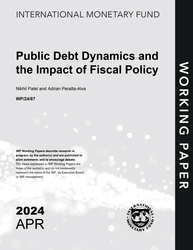
Public Debt Dynamics and the Impact of Fiscal Policy
Public Debt Dynamics and the Impact of Fiscal Policy
READ MORE...
Volume/Issue:
Volume 2024
Issue 087
Publication date: April 2024
ISBN: 9798400273476
$20.00
Add to Cart by clicking price of the language and format you'd like to purchase
Available Languages and Formats
| English |
Prices in red indicate formats that are not yet available but are forthcoming.
Topics covered in this book
This title contains information about the following subjects.
Click on a subject if you would like to see other titles with the same subjects.
Economics- Macroeconomics , Public Finance , Economics / General , Public Debt , Fiscal Consolidation , Structural Vector Autoregression , , GDP growth shock , discretionary fiscal policy change , public debt dynamics , sign restriction , growth shock , Fiscal stance , Vector autoregression , Structural vector autoregression , Global
Summary
Public debt-to-GDP ratios have undergone substantial fluctuations over both the short and long term. Most recently, global debt-to-GDP ratios peaked at 100% on average in 2020 due to COVID-19, retracting substantially by 2022. To understand what drives these movements, we propose a structural approach to debt decompositions based on a SVAR identified with narrative sign restrictions. We find that GDP growth shocks and the corresponding comovements of macroeconomic variables are the key drivers of debt to GDP, accounting for 40% of the observed yearly variation in 17 advanced economies since the 1980s. Discretionary fiscal policy changes, in turn, account for less than 20% of the observed changes. The analysis also finds the primary balance multiplier on GDP to be very small. We reconcile our results with the literature, underscoring the importance of accurate shock identification and accounting for cross-country heterogeneity.
Copyright © 2010 - 2025
Powered by:
AIDC



